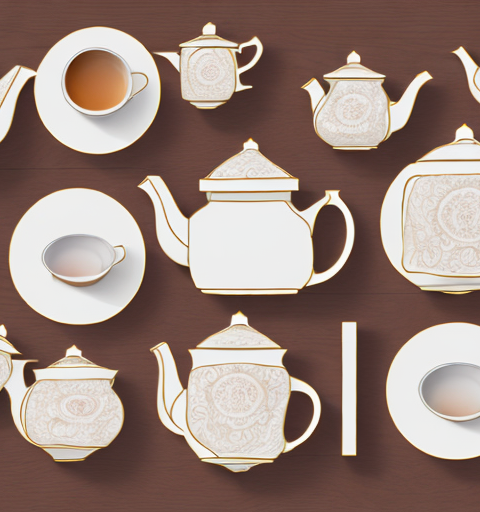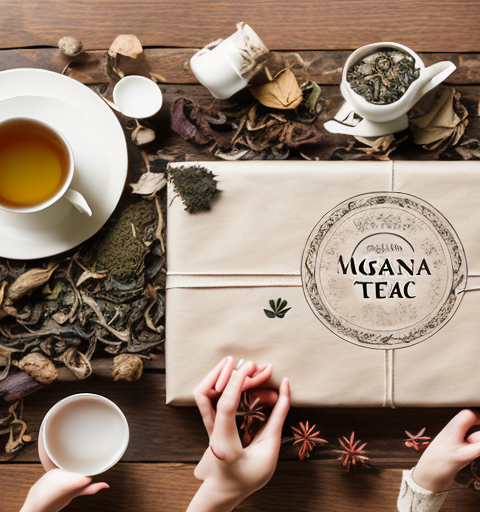Understanding the Cause of Tea Stains on Ceramic Teapots
Tea stains on ceramic teapots can be quite unsightly, especially if you own a teapot with intricate designs. It’s important to understand the cause of these stains to effectively remove them. The tannins present in tea are responsible for the discoloration of the ceramic surface. Over time, these tannins can build up and form stubborn stains. Other factors such as the temperature of the water, the type and quality of the tea leaves, and the frequency of use can also contribute to the formation of tea stains.
One factor that can contribute to the formation of tea stains on ceramic teapots is the type and quality of the water used. Hard water, which contains high levels of minerals such as calcium and magnesium, can leave behind mineral deposits on the surface of the teapot. These deposits can interact with the tannins in the tea and result in more pronounced stains.
Additionally, the material of the teapot itself can play a role in the formation of tea stains. Ceramic teapots with porous surfaces are more prone to staining as the tannins can seep into the tiny pores and become trapped. On the other hand, teapots with glazed surfaces are less likely to develop stains as the glaze creates a protective barrier.
Exploring the Importance of Removing Tea Stains from Ceramic Teapots
While tea stains may seem like a minor cosmetic issue, it is important to remove them from your ceramic teapot for several reasons. Firstly, tea stains can affect the taste and aroma of your brewed tea. The residual tannins from the stains can transfer into your tea, altering its flavor profile. Secondly, tea stains can compromise the overall appearance and beauty of your teapot, particularly if it has intricate designs. Removing these stains will restore the teapot’s visual appeal. Lastly, regular cleaning and maintenance of your ceramic teapot can help prolong its lifespan, ensuring that it remains in good condition for years to come.
Additionally, the presence of tea stains can also lead to the growth of bacteria and mold in your ceramic teapot. The damp environment created by the stains provides a breeding ground for these microorganisms, which can be harmful to your health if ingested. By regularly removing tea stains, you can prevent the buildup of bacteria and mold, ensuring that your teapot remains hygienic and safe to use.
Step-by-Step Guide: Removing Tea Stains from a Ceramic Teapot
To remove tea stains from a ceramic teapot, follow these step-by-step instructions:
- Start by filling your teapot with warm water.
- Add a few drops of mild dish soap and gently stir the mixture.
- Allow the teapot to soak for about 15 minutes.
- Next, use a soft sponge or brush to scrub the stained areas gently.
- Rinse the teapot thoroughly with warm water.
- If the stains persist, create a paste using baking soda and water.
- Apply the paste to the stained areas and let it sit for a few minutes.
- Gently scrub the teapot again, focusing on the stained areas.
- Rinse the teapot once more with warm water and dry it thoroughly.
Following these steps will help remove tea stains from your ceramic teapot, restoring its original shine and beauty.
It is important to note that if your ceramic teapot has any delicate or intricate designs, you should avoid using abrasive materials or harsh chemicals, as they may damage the surface. Instead, opt for gentler cleaning methods, such as using a mixture of vinegar and water or a specialized ceramic cleaner. Always read and follow the manufacturer’s instructions for cleaning and care to ensure the longevity of your teapot.
Choosing the Right Cleaning Method for Your Ceramic Teapot
There are several cleaning methods available for removing tea stains from ceramic teapots. The method you choose depends on the severity of the stains and the materials you have at hand. As mentioned earlier, a mixture of warm water and mild dish soap is often effective for mild to moderate stains. For more stubborn stains, you can try using baking soda or white vinegar. It is important to note that abrasive cleaners or harsh chemicals should be avoided, as they can damage the delicate surface of your teapot and its intricate designs. Always opt for gentle cleaning methods to preserve the quality and appearance of your ceramic teapot.
Another effective cleaning method for ceramic teapots is using lemon juice. Lemon juice contains natural acids that can help break down stubborn tea stains. Simply squeeze fresh lemon juice onto a soft cloth or sponge and gently scrub the stained areas of the teapot. Rinse thoroughly with warm water afterwards to remove any residue. This method is particularly useful for teapots with lighter-colored glazes, as lemon juice can also help brighten and restore the shine of the ceramic surface.
Natural Remedies for Removing Tea Stains from Ceramic Teapots
If you prefer using natural remedies to remove tea stains from your ceramic teapot, you’re in luck! There are several household items that can be highly effective in tackling these stubborn stains. Lemon juice, for example, can work wonders due to its acidity. Simply apply some lemon juice to the stained areas, let it sit for a few minutes, and then gently scrub away the stains. Another natural remedy is to create a paste using baking soda and water. Apply the paste to the tea stains and let it sit before scrubbing. These natural remedies are not only effective but also safe to use, ensuring that your ceramic teapot remains in pristine condition.
In addition to lemon juice and baking soda, vinegar is another natural remedy that can be used to remove tea stains from ceramic teapots. The acetic acid in vinegar helps break down the stains and remove them effectively. Simply soak a cloth or sponge in vinegar and gently scrub the stained areas. Rinse the teapot thoroughly with water afterwards to remove any vinegar residue.
If you’re looking for a natural remedy that not only removes tea stains but also adds a pleasant fragrance to your teapot, consider using a mixture of tea tree oil and water. Tea tree oil has natural cleaning properties and can help eliminate stains and odors. Mix a few drops of tea tree oil with water and apply the mixture to the stained areas. Let it sit for a few minutes before scrubbing away the stains. This remedy not only cleans your teapot but also leaves it smelling fresh and clean.
The Best Cleaning Products for Eliminating Tea Stains on Ceramic Teapots
If you prefer using commercial cleaning products to remove tea stains from your ceramic teapot, there are many options available. Look for products specifically designed for removing stains from ceramics or teapots. These products often contain gentle cleaning agents that effectively break down the tannins without causing any damage to the teapot’s surface. Read the instructions carefully, and follow them to achieve the best results. Remember to test the cleaning product on a small, inconspicuous area of the teapot first to ensure compatibility and avoid any potential damage.
In addition to commercial cleaning products, there are also natural alternatives that can effectively remove tea stains from ceramic teapots. One popular option is using a mixture of baking soda and water. Create a paste by combining equal parts baking soda and water, then apply it to the stained areas of the teapot. Let it sit for a few minutes before scrubbing gently with a soft sponge or cloth. Rinse thoroughly with water to remove any residue. Another natural option is using white vinegar. Simply soak a cloth or sponge in white vinegar and wipe the stained areas of the teapot. Allow the vinegar to sit for a few minutes before rinsing with water. These natural cleaning methods are not only effective but also safe for both you and the environment.
Tips and Tricks for Preventing Tea Stains on Ceramic Teapots
Prevention is always better than cure, and this holds true for tea stains on ceramic teapots as well. By taking a few simple precautionary measures, you can minimize the formation of tea stains and keep your teapot looking clean and beautiful. Here are some tips and tricks:
- Regularly rinse your teapot with warm water after each use.
- Avoid leaving brewed tea in the teapot for extended periods.
- If you notice any stains starting to form, address them promptly to prevent them from becoming more stubborn.
- Consider using a tea cozy or tea strainer to minimize contact between the tea leaves and the teapot’s interior surface.
- Periodically deep clean your teapot using the step-by-step guide mentioned earlier to ensure any accumulated tea stains are removed.
By incorporating these preventive measures into your teapot maintenance routine, you can enjoy your teapot’s intricate designs without worrying about tea stains.
Another helpful tip for preventing tea stains on ceramic teapots is to avoid using abrasive cleaning tools or harsh chemicals. These can damage the surface of the teapot and make it more prone to staining. Instead, opt for gentle cleaning methods such as using a soft sponge or cloth.
In addition, it’s important to store your teapot properly when not in use. Make sure it is completely dry before storing it, as moisture can contribute to the formation of stains. Consider using a dust cover or placing the teapot in a cabinet to protect it from dust and potential damage.
A Deep Dive into the Science of Tea Stain Removal from Ceramic Teapots
Understanding the science behind tea stain removal from ceramic teapots can provide valuable insights into effective cleaning methods. The tannins present in tea leaves have a natural affinity for porous surfaces, such as ceramic. When tea contacts the surface of the teapot, the tannins can seep into microscopic pores and form stains over time. Cleaning agents that contain surfactants work by breaking down and dispersing these tannins, allowing them to be washed away. It is important to choose cleaning agents that are specifically formulated for removing tea stains without causing any damage to the ceramic teapot.
Additionally, it is worth noting that certain natural remedies can also be effective in removing tea stains from ceramic teapots. For example, a mixture of baking soda and water can be applied to the stained areas and gently scrubbed with a soft brush. The alkaline properties of baking soda help to break down the tannins and lift the stains. Another natural option is to use white vinegar, which can be applied directly to the stains and left to sit for a few minutes before rinsing. The acidic nature of vinegar helps to dissolve the tannins and remove the stains. However, it is important to test these remedies on a small, inconspicuous area of the teapot first to ensure they do not cause any damage.
Common Mistakes to Avoid When Removing Tea Stains from Ceramic Teapots
While removing tea stains from ceramic teapots may seem like a straightforward task, there are some common mistakes that should be avoided to ensure optimal results. Firstly, using abrasive cleaners or scrubbing brushes can scratch the delicate surface of the teapot, damaging the intricate designs. Secondly, applying excessive force when scrubbing can also lead to scratches or cracks. It is important to be gentle yet thorough when cleaning your teapot. Lastly, neglecting to rinse the teapot thoroughly after cleaning can leave behind residue or cleaning agents that can affect the taste of your brewed tea. Avoiding these mistakes will help you successfully remove tea stains without causing any harm to your teapot.
Another common mistake to avoid when removing tea stains from ceramic teapots is using harsh chemicals. While it may be tempting to use strong cleaning agents to tackle stubborn stains, these chemicals can actually damage the surface of the teapot and strip away its protective glaze. It is best to opt for gentle, natural cleaning solutions that are specifically formulated for ceramic surfaces.
In addition, it is important to avoid soaking the teapot for extended periods of time. While soaking can help loosen tea stains, leaving the teapot submerged for too long can cause the water to seep into any cracks or chips in the ceramic, potentially causing further damage. Instead, aim for shorter soaking times and use a soft cloth or sponge to gently scrub away the stains.
Expert Advice: How Professionals Remove Tea Stains from Ceramic Teapots
When it comes to removing tea stains from ceramic teapots, professionals have developed their own tried-and-true methods. One common approach is to use a combination of mild dish soap, warm water, and a soft sponge. Professionals often recommend gently scrubbing the stained areas in circular motions to break down the stains effectively. Additionally, they emphasize the importance of rinsing the teapot thoroughly to remove any residue. If the stains are particularly stubborn, professionals may resort to using specialized commercial cleaning products that are specifically formulated for ceramic teapot stain removal. Overall, their advice highlights the significance of being cautious, patient, and using gentle cleaning techniques to preserve the integrity of the teapot.
Restoring the Beauty of Your Ceramic Teapot: Removing Stubborn Tea Stains
If you have neglected your ceramic teapot and it now has stubborn tea stains, don’t despair! With a little time and effort, you can restore its beauty. Start by following the step-by-step guide mentioned earlier. If the stains persist, you can try more intensive cleaning methods such as using a paste of baking soda and white vinegar or using a specialized ceramic cleaner. It may require multiple attempts to completely remove stubborn stains, so be patient and persistent. Once the stains are gone, ensure you follow preventive measures and regular cleaning routines to keep your teapot looking impeccable.
DIY vs Professional Cleaning: Which is Better for Your Ceramic Teapot?
Deciding between DIY cleaning and professional cleaning for your ceramic teapot depends on various factors. If the tea stains are mild to moderate and you feel confident in your cleaning abilities, opting for DIY cleaning methods can be a cost-effective and convenient choice. However, if the teapot has intricate designs or the stains are particularly stubborn, seeking the expertise of professional cleaners may be the best course of action. Professionals have specialized tools and knowledge to handle delicate teapots and stubborn stains effectively. Before making a decision, consider the condition of your teapot, the severity of the stains, and your personal preferences.
Exploring Different Types of Tea Stain Removal Techniques for Ceramic Teapots
When it comes to tea stain removal techniques for ceramic teapots, there are multiple options available. Some of the popular methods include using lemon juice, baking soda, vinegar, or specialized cleaning products. Each technique has its own advantages and works well for different types of stains. Experiment with different methods to find the one that works best for your teapot. Remember that the effectiveness of a technique may vary depending on the specific teapot, the severity of the stains, and personal preferences. It’s always a good idea to start with milder methods and gradually progress to more intensive techniques if needed.
The Art of Preserving Intricate Designs while Removing Tea Stains from Ceramic Teapots
Preserving the intricate designs on your ceramic teapot while removing tea stains requires a delicate touch. To avoid damaging the designs, it is essential to use gentle cleaning methods. Avoid using abrasive scrubbing brushes or harsh cleaning agents that can scratch or fade the designs. Instead, opt for soft sponges or brushes specifically designed for delicate surfaces. Take your time and apply gentle pressure when scrubbing the stained areas. By following these precautions and being mindful of the teapot’s delicate features, you can successfully remove tea stains while preserving the beauty and intricate designs of your ceramic teapot.






